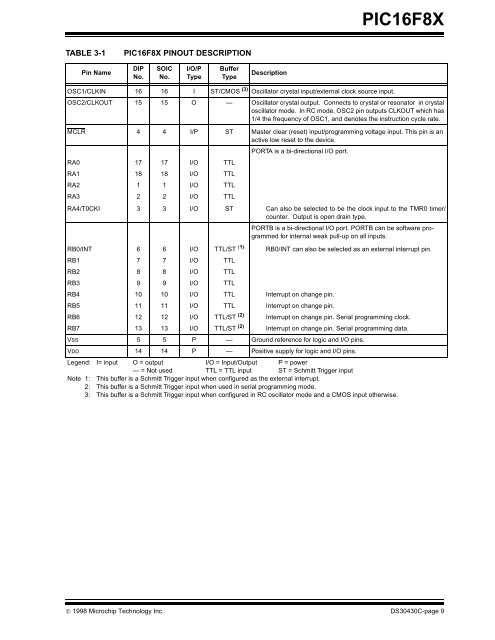PIC16F8X, 18-Pin FLASH/EEPROM 8-Bit MCU Data Sheet - Microchip
PIC16F8X, 18-Pin FLASH/EEPROM 8-Bit MCU Data Sheet - Microchip
PIC16F8X, 18-Pin FLASH/EEPROM 8-Bit MCU Data Sheet - Microchip
Create successful ePaper yourself
Turn your PDF publications into a flip-book with our unique Google optimized e-Paper software.
TABLE 3-1 <strong>PIC16F8X</strong> PINOUT DESCRIPTION<br />
<strong>Pin</strong> Name<br />
DIP<br />
No.<br />
SOIC<br />
No.<br />
I/O/P<br />
Type<br />
Buffer<br />
Type<br />
Description<br />
<strong>PIC16F8X</strong><br />
OSC1/CLKIN 16 16 I ST/CMOS (3) Oscillator crystal input/external clock source input.<br />
OSC2/CLKOUT 15 15 O — Oscillator crystal output. Connects to crystal or resonator in crystal<br />
oscillator mode. In RC mode, OSC2 pin outputs CLKOUT which has<br />
1/4 the frequency of OSC1, and denotes the instruction cycle rate.<br />
MCLR 4 4 I/P ST Master clear (reset) input/programming voltage input. This pin is an<br />
active low reset to the device.<br />
PORTA is a bi-directional I/O port.<br />
RA0 17 17 I/O TTL<br />
RA1 <strong>18</strong> <strong>18</strong> I/O TTL<br />
RA2 1 1 I/O TTL<br />
RA3 2 2 I/O TTL<br />
RA4/T0CKI 3 3 I/O ST Can also be selected to be the clock input to the TMR0 timer/<br />
counter. Output is open drain type.<br />
PORTB is a bi-directional I/O port. PORTB can be software programmed<br />
for internal weak pull-up on all inputs.<br />
RB0/INT 6 6 I/O TTL/ST (1)<br />
RB0/INT can also be selected as an external interrupt pin.<br />
RB1 7 7 I/O TTL<br />
RB2 8 8 I/O TTL<br />
RB3 9 9 I/O TTL<br />
RB4 10 10 I/O TTL Interrupt on change pin.<br />
RB5 11 11 I/O TTL Interrupt on change pin.<br />
RB6 12 12 I/O TTL/ST (2)<br />
Interrupt on change pin. Serial programming clock.<br />
RB7 13 13 I/O TTL/ST (2) Interrupt on change pin. Serial programming data.<br />
VSS 5 5 P — Ground reference for logic and I/O pins.<br />
VDD 14 14 P — Positive supply for logic and I/O pins.<br />
Legend: I= input O = output I/O = Input/Output P = power<br />
— = Not used TTL = TTL input ST = Schmitt Trigger input<br />
Note 1: This buffer is a Schmitt Trigger input when configured as the external interrupt.<br />
2: This buffer is a Schmitt Trigger input when used in serial programming mode.<br />
3: This buffer is a Schmitt Trigger input when configured in RC oscillator mode and a CMOS input otherwise.<br />
© 1998 <strong>Microchip</strong> Technology Inc. DS30430C-page 9

















